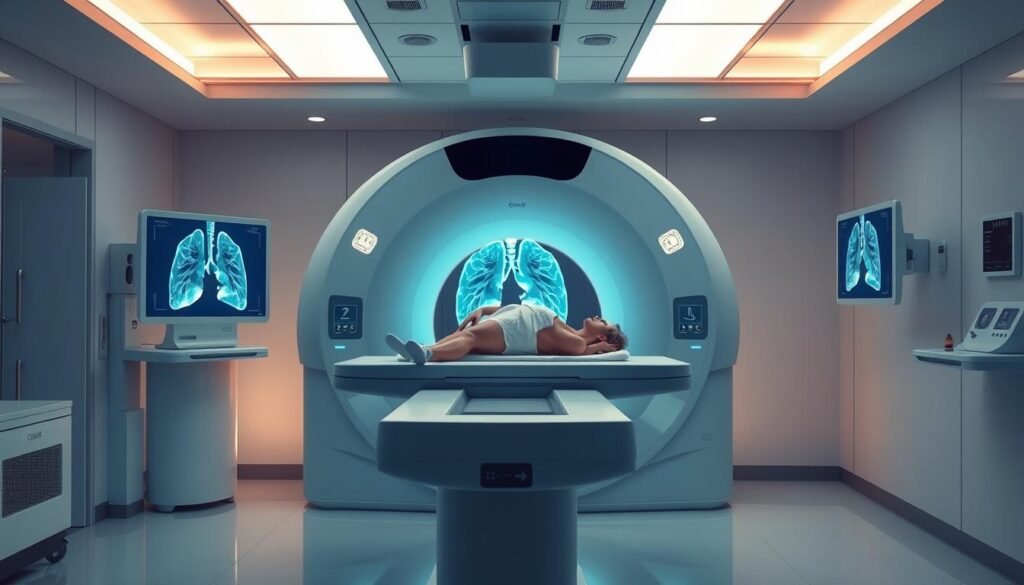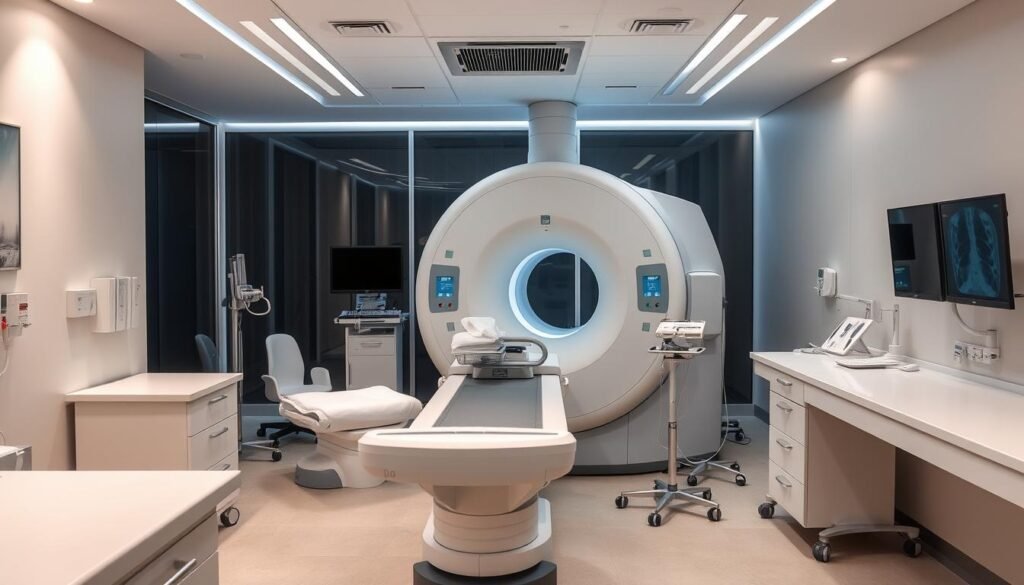Studies show lung cancer screening can cut the death risk by up to 20%. Lung cancer is the top cause of cancer deaths in the U.S. Early detection is key. A low-dose computed tomography (LDCT) scan is one of the best ways for early detection. It’s highly recommended for those 50 to 80 years old with a history of heavy smoking.
High-risk individuals, like heavy smokers, need regular screening. LDCT scans spot lung nodules that might be cancer. Screening combines medical history, exams, and tests like X-rays and MRIs. These steps are crucial for lung cancer management. Talking to doctors about these steps can boost lung health. For more on lung cancer diagnosis, check how lung cancer is diagnosed.
Key Takeaways
- Lung cancer screening can significantly lower mortality rates associated with the disease.
- LDCT scans are the primary tool in lung cancer screening.
- Recommended for high-risk individuals aged 50 to 80 with a significant smoking history.
- Screening may uncover other health issues related to smoking.
- Regular discussions with healthcare providers about screening are advised.
- Insurance often covers lung cancer screening tests, making it accessible.
What Is Lung Cancer Screening?
Lung cancer screening checks for cancer before you show symptoms. It mainly uses a method called low-dose computed tomography (LDCT). LDCT takes clear pictures of your lungs with a small amount of radiation. This helps find lung cancer early, which can save lives.
Screening is key for older adults who’ve smoked a lot. Since most lung cancers start in smokers, finding it early can be life-saving. The American Cancer Society suggests yearly LDCT scans for people 50 to 80 years old. They must have smoked a lot over the years.
Finding lung cancer early means better treatment options. Treatments like stereotactic body radiation therapy (SBRT) work best early on. Early detection allows for better decisions and increases the chance of beating cancer.
LDCT screens can show lung issues that might be cancer. Doctors use other tools like CT and MRI scans, too. They also use PET scans to fully assess your lungs. For more on imaging methods, see MRI vs. CT scans for lung cancer here.
Using screening right means working with experts. Specialized centers have the tools and teams to follow up on tests. They help people with abnormal results figure out the next steps.
If you’re worried about lung cancer, know the early signs. This knowledge can lead to quick action. Learn more about early signs of lung cancer here. It’s key for awareness.
Lung cancer screening is a vital tool against the disease. It helps high-risk people by finding cancer early. This leads to better treatment chances.
Importance of Early Detection
Finding lung cancer early is key to better survival rates and treatments. When found early, treatments can work more effectively, making a big difference in the outcome. Studies show that catching lung cancer early greatly lowers death rates. This highlights why regular checks are important, especially for people at higher risk.
Low-dose CT scans are now the best way for finding lung cancer early. They can spot small issues that regular scans might miss. The National Lung Screening Trial showed these scans can cut the risk of dying from lung cancer by up to 20%. This proves staying ahead with health checks is crucial, especially for heavy smokers or those who’ve stopped smoking recently.
It’s tougher to treat lung cancer once it’s advanced, leading to worse survival chances and health results. Often, there are no symptoms until the cancer has grown, making regular screenings essential. These are vital for people 50 to 80 years old with a heavy smoking past. Without early detection, beating lung cancer becomes much harder, stressing the need for awareness.
| Stage | Description | Typical Treatment |
|---|---|---|
| 1 | Cancer confined to the lungs | Surgery, targeted therapy |
| 2 | Cancer spread to nearby lymph nodes | Surgery, chemotherapy, radiation therapy |
| 3 | Cancer spread to chest structures and lymph nodes | Combination of chemotherapy and radiation therapy |
| 4 | Cancer spread to distant organs | Palliative care, immunotherapy |
Who Should Consider Lung Cancer Screening?
Lung cancer screening is key for high-risk groups. It is most beneficial for those aged 50 to 80. Especially, it helps those who have smoked a lot over the years. The U.S. Preventive Services Task Force (USPSTF) says to screen people with at least 20 pack-years of smoking. This group includes current smokers and those who have quit in the last 15 years.
The age of a person is important in deciding if they need screening. The typical age to get lung cancer is considered during screenings. Getting screened at the right time can find cancer early. This can lead to better chances of survival. Research has found that low-dose CT scans can lower lung cancer deaths by 15 to 20 percent. This is for those who follow the screening advice.
When thinking about screening, one’s health status matters too. People with certain health conditions might face more risks from further tests. So, it’s critical to check your health well before starting screening. Groups like the American Lung Association suggest yearly LDCT scans for those who fit the screening criteria. They stress that finding cancer early is very important.

| Criteria for Lung Cancer Screening | Details |
|---|---|
| Age | 50 to 80 years |
| Smoking History | 20 pack-years or more |
| Current or Recent Smokers | Current smokers or those who quit within the last 15 years |
| Existing Health Issues | Assessment of existing health conditions recommended |
| Screening Method | Annual LDCT scans |
Screening Techniques: Low-Dose CT Scans
Low-dose computed tomography (LDCT) is the top way to find lung cancer early. It uses much less radiation than regular CT scans. For instance, an LDCT scan uses about 1.4 mSv of radiation. That’s a lot less than the 7 mSv from standard scans. This means it’s safer and can be done more often, especially for those at high risk for lung cancer.
The value of LDCT scans isn’t just in the lower radiation. Research, like the 2020 Dutch-Belgian NELSON trial, shows they really make a difference. They reduced lung cancer deaths by 24% in men and 33% in women. The American Cancer Society thinks yearly LDCT screenings could save 60,000 lives in the U.S. every year.

People aged 50 to 80 who smoked a lot are advised to get LDCT scans every year. Yet, these scans have some downsides too. There’s still some radiation, and they might find things that seem wrong but aren’t. This can lead to unnecessary worry. More tests might be needed to figure out these findings.
Still, LDCT scans are crucial for catching lung tumors early. This can improve your chances of beating the disease and living longer. Since lung cancer is a top cause of cancer deaths, using effective screening methods like LDCT is key. It helps people manage their health better and stay ahead of the disease.
How Is Lung Cancer Screening Done?
Lung cancer screening is a key step in finding cancer early. It can greatly improve chances of survival. A common method is the low-dose CT scan. It’s known for being efficient and accurate in taking images of the lungs. Before this scan, patients go through detailed preparations.
Preparation for an LDCT Scan
Getting ready for an LDCT scan is important to avoid any issues. Patients need to:
- Notify healthcare providers of any current respiratory infections.
- Remove all metal accessories, such as jewelry or belts, that could affect the scan.
- Wear clothing without metal, like hospital gowns.
This preparation helps make sure the CT scan goes smoothly. It helps get clear images for an accurate assessment.
What to Expect During the Scan
The lung cancer scan is a straightforward process. Patients lie on a table that moves them through the scanner. They might be asked to hold their breath for a short time while images are taken. Each scan takes under a minute.
Overall, the process lasts about 30 minutes. This allows for a thorough check in a short amount of time.

Additional Screening Methods: MRI and More
Low-dose computed tomography (LDCT) is the top choice for lung cancer checks. Still, MRI plays a crucial role, especially in staging lung cancer and looking at tumor details. MRI gives clear images of soft tissue. This lets us closely study malignant lung spots and understand pulmonary nodules found via CT scans.
Understanding lung cancer on MRI
MRI is great for staging lung cancer in some cases. Studies show MRI is really sensitive in finding issues. It’s especially good with certain techniques, better than PET-CT at seeing mediastinal nodes. For nodules 5 mm or bigger, MRI spots them with a 100% success rate. This skill is key in knowing if lung nodules could be cancerous. Nodules over 8 mm without calcium are at high cancer risk, making accurate imaging essential.
MRI vs. CT for Lung Cancer Detection
When comparing MRI and CT for finding lung nodules, each has its pros. MRI detects nodules 82.5% of the time, while CT finds them 97% of the time. But, MRI shines in certain areas like understanding tumors and seeing if cancer has spread. New technology boosts MRI, making scans faster and without needing ECG. These improvements help doctors decide on the best care faster.
Benefits and Risks of Lung Cancer Screening
Lung cancer screening mainly helps in finding cancer early. Studies show that catching lung cancer early makes it easier to treat. Using low-dose CT scans, over half of lung cancer cases are caught early. This greatly improves chances of beating the disease. Without screening, only about 25% of these cases are found early.
However, lung cancer screening has its downsides. About 12-14% of initial tests might wrongly suggest cancer is present. This can cause worry and lead to more tests. But, if you get checked every year, this risk drops to about 6%.
Another issue is overdiagnosis. Sometimes, tests might mistake non-cancerous conditions for cancer. This could lead to treatments that were not needed. Also, there is a concern about the radiation from the tests. But, the radiation from one screening is as much as the average American gets in six months from natural sources.
So, patients should talk with their doctors about lung cancer screening’s pros and cons. Knowing both can help you make choices that fit your health needs.
| Screening Aspect | Initial Screening | Continued Annual Screening |
|---|---|---|
| False Positives | 12-14% | 6% |
| Incidental Findings | 6 out of 100 | 2 out of 100 |
| Radiation Exposure | Equivalent to 6 months of natural background | Same |
Understanding Results from Lung Cancer Screening
Understanding the results from lung cancer screening is crucial. It sets the path for future treatment. If no issues are found, doctors usually suggest yearly tests. This helps keep an eye on the lungs over time.
But, if there are abnormal results like nodules, a closer look is needed. Small nodules often don’t need quick action. Yet, bigger or growing ones might. A specialist can then check further to make sure there’s no cancer.
Working together with doctors is key during this. Talking about the screening results helps patients know their choices. For example, making decisions on lung nodules can affect their care plan. Patients should understand the different outcomes from the screening.
So, understanding lung cancer screening results is very important for patient care. Reading resources like this article can help. They offer more on managing nodules and what to do next. Being active in talks about further tests can change the results for those at risk of lung cancer.